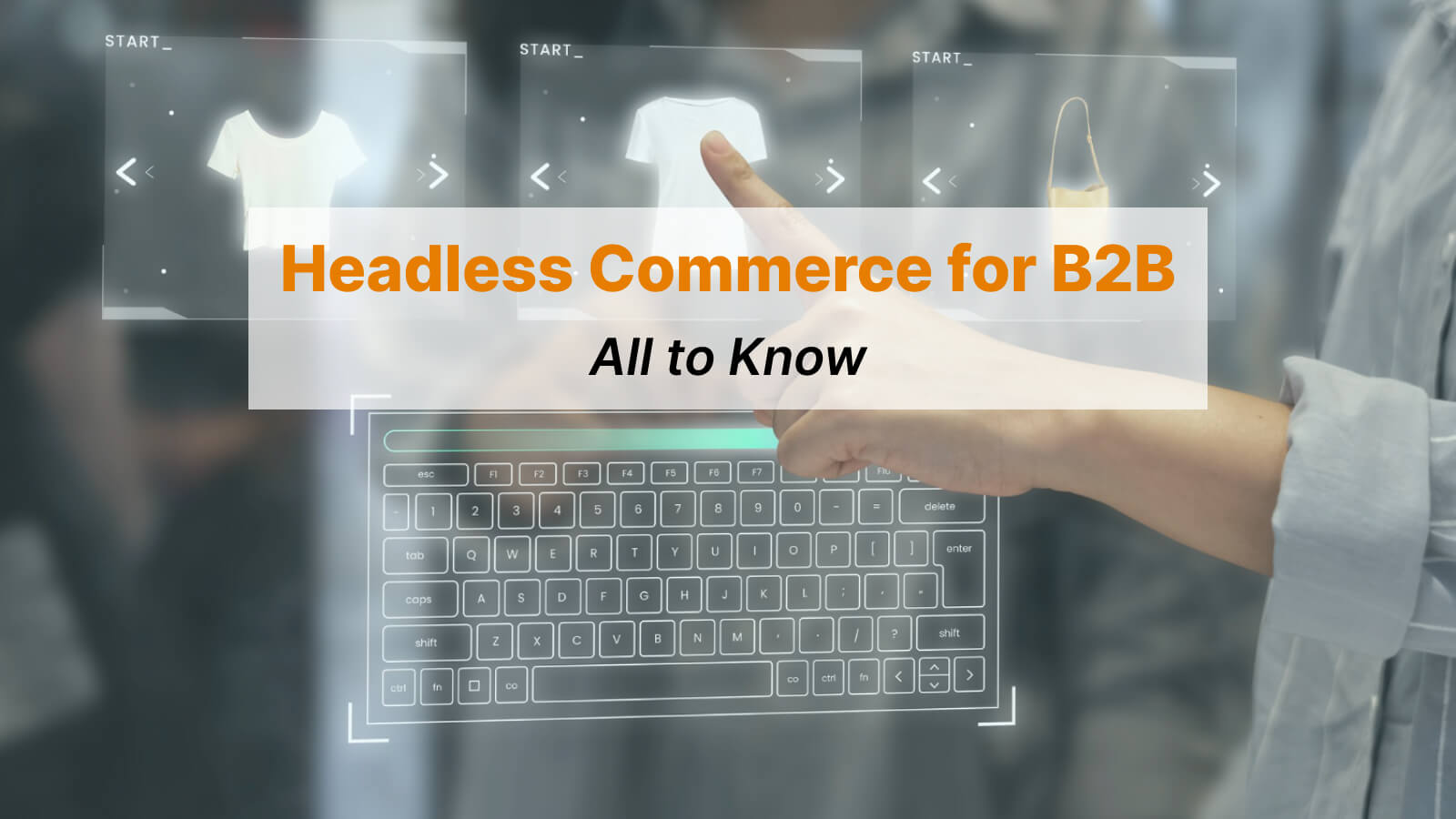Headless commerce for B2B websites is becoming very popular thanks to its capability of making websites work better and faster, and it’s easier to make changes quickly. With headless commerce, stores can be more creative, and developers can build unique online shopping experiences using their favorite tools. But setting up a headless system isn’t as simple as it sounds, and it might not be the best choice for every business.
Before you decide to use headless commerce, it’s important to really understand what it involves. BSS Commerce Shopify will guide you on how to make the most of headless commerce for B2B online stores, its benefits, and how Shopify has helped thousands of brands succeed with it.
Contents
- 1 Headless Commerce for B2B: Overview
- 2 Main Benefits of Headless Commerce for B2B
- 3 Crucial Steps to Adopting a Headless Commerce for B2B
- 4 Headless Commerce B2B for Shopify
- 5 Best Success Stories about Headless Commerce for Shopify
- 6 Bottom Line – Is Headless Commerce the Right Choice for Your B2B eCommerce Business?
Headless Commerce for B2B: Overview
What is Headless Commerce?
Headless commerce is an eCommerce framework in which the front-end presentation layer is decoupled from the back-end functionality. This separation enables the seamless delivery of content across different platforms, such as websites, applications, kiosks, and Internet of Things (IoT) devices.

This framework is highly favored by brands as it provides them with the flexibility to create distinctive storefront experiences that are usually limited to traditional, all-in-one platforms. Developers are particularly enthusiastic about adopting the headless approach because it grants them a higher degree of control over the development process and allows them to utilize a combination of cutting-edge commerce tools that best suit their needs.
You may design alternative front-end experiences for various client touchpoints thanks to headless commerce. The API layer enables your web, mobile, voice, and point of sale (POS) front-ends to communicate with a single backend system, enabling developing firms to become truly omnichannel and grow quickly globally.
How Does Headless Commerce Work?
Headless commerce operates by separating the frontend presentation layer from the backend commerce functionality. Instead of a single software managing both the display and backend processes, multiple technologies can be employed for these tasks. Through APIs, the frontend and backend can communicate and exchange data seamlessly.
What is Headless Commerce Best for?
Headless commerce solution is beneficial for any retailer, brand, or B2B business seeking to connect with shoppers on a personalized level and gain customer data insights. While larger retailers may have the necessary resources and IT infrastructure to adapt their existing commerce platforms, smaller brands specifically require a headless commerce solution.
For instance, a growing footwear brand may prioritize engaging with customers on social media platforms such as Instagram. However, the brand may not want to heavily invest in building an eCommerce website, which would involve creating a product catalog and other functionalities.
Thanks to the headless commerce solution, the brand can concentrate on engaging with customers on social media and deliver a seamless, personalized experience that drives sales from the channels where shoppers are already active, such as Instagram, Facebook, Shopify, and more.
Discover now how difference between Headless Commerce vs Traditional Commerce
Main Benefits of Headless Commerce for B2B
Headless commerce offers flexibility and is capable of anticipating the rapid evolution of commerce and positioning businesses to adapt to new technologies and trends. Here are the main benefits of headless commerce for B2B:
#1. Develop speedy websites
When considering online shopping, it is crucial to prioritize maintaining a quick page load speed. Almost all consumers have stated that page speed directly impacts their decision to purchase from an online retailer.
Fortunately, the headless commerce solution centralizes content and can distribute it anywhere through APIs. This approach enables much faster content delivery compared to traditional eCommerce platforms, thereby leading to better customer experiences.
#2. Developers benefit from the adaptability and ease of use
Headless commerce provides stores with the flexibility to choose the eCommerce platform that best suits their online store while also allowing them to work with their preferred front-end solution, such as a CMS, DXP, PWA, or custom solution.

Thanks to adopting a headless approach, development teams can leverage their preferred technology or programming language, ensuring compatibility with their existing workflow and enhancing overall efficiency.
#3. Scalability
As new trends appear and the business landscape changes, using headless technologies can protect your brand for the future. This means you can change the way your website looks (the front end) without having to change the underlying system (the back end). With the help of APIs, the people who build your website can add more features to your current system and use different tools as needed.
Instead of creating a whole new website with a headless solution, you can add each new feature one at a time and bring in new features as your website gets bigger.
#4. Enhance conversion rates while reducing expenses
One effective method to limit customer acquisition costs is by implementing a headless commerce approach. This strategy allows your brand to focus on creating engaging content or experiences to attract organic traffic, rather than solely depending on paid advertising.
Experimenting with different frontend solutions alongside a consistent backend can help determine which approach drives the most traffic. Through continuous testing and exploring various templates, you can enhance your understanding of your target audience and boost your conversion rate more efficiently compared to conventional online businesses.
#5. Efficiency in marketing
When using a traditional monolithic system, your options for developing new front-end experiences may be limited. However, through using a headless commerce solution, you can seamlessly integrate new technologies and adapt to emerging trends. This grants your marketing team the freedom to innovate and create multiple user experiences across various channels, all without disrupting your backend processes.
#6. Can test new technology
In a headless environment, companies have the opportunity to experiment with cutting-edge technology. Thanks to separating the front end from the back end, developers have the freedom to innovate without being limited by the constraints of a conventional CMS.
The front end, also known as the “head,” dictates the appearance of most online stores. Going headless provides greater versatility in delivering content, as it allows for integration with a CMS, DXP, or IoT device tailored for content-driven commerce. This enables easy front-end changes without disrupting back-end functionalities.
Having explored the main benefits of headless commerce for B2B, let’s now delve into how these advantages can be specifically harnessed using a platform like Shopify for your B2B eCommerce needs in the section below.
#7. Omnichannel
Commerce has evolved from being confined to physical stores and home computers to being omnipresent. Today, people shop using mobile devices, social networks, online marketplaces like Google Shopping and Amazon, and even through IoT devices. eCommerce stores aiming to leverage this multi-channel shopping trend need to provide commerce everywhere.
For stores targeting audiences across platforms, headless commerce can enable a seamless omnichannel experience by connecting all consumer touchpoints. This is made possible by powerful and flexible APIs, which allow businesses to connect different frontend experiences to a single backend.
Explore now to learn more about Shopify Omnichannel
#8. Customization and innovation
Many choose headless commerce because it allows for big ideas that can’t be achieved with a single system. In the past, they may have used open-source platforms for customization but struggled with long development cycles and maintenance. Headless commerce lets them maintain customization without the cost and upkeep.
Therefore, creating innovative and captivating digital experiences is crucial for the success of an eCommerce business. Using a headless commerce solution can streamline the process of tailoring and adapting your website to remain at the forefront of the industry.
Crucial Steps to Adopting a Headless Commerce for B2B
3 easy steps to adopt a headless commerce framework:
Step 1: Select an eCommerce platform that can support headless commerce. This entails choosing a platform that can handle a large number of API calls, as this is crucial for communication between the frontend and backend systems. You can consider Shopify and enjoy your first month for just $1.
Step 2: Once you have chosen your eCommerce platform, decide on the frontend solution or solutions that you would like to integrate with headless commerce. If you are already familiar with or currently using a specific technology, it may be a good starting point.
Step 3: After selecting your preferred technology, you will likely require the assistance of a developer agency or in-house support to construct and design your website.
Headless Commerce B2B for Shopify
Shopify has assisted numerous businesses including B2B and B2C merchants in transitioning to a headless commerce framework. Thanks to Shopify’s comprehensive set of headless development tools, developers and merchants can create top-notch custom experiences more efficiently and cost-effectively.
Shopify’s headless commerce solutions allow both B2B and B2C merchants and developers to select the most suitable tools for their needs and enhance store performance through a flexible stack of technologies.
Shopify’s headless solutions include:
1. Storefront API, Shopify’s headless API layer
2. Hydrogen and Oxygen, Shopify’s official development stack for headless commerce
Let’s delve deeper into how each of these components enables businesses of all sizes to embrace a headless commerce B2B framework:
Storefront API
The Storefront API is the backbone of Shopify’s headless platform, offering access to Shopify’s full range of commerce features essential for customer interactions. These include an optimized cart, product and collection pages, search and recommendations, contextual pricing, and B2B functionalities like subscriptions. The API is compatible with any framework, device, and service platform, allowing developers to use their preferred tools and explore new technologies. They can build with any development framework and connect to any third-party system with an API.
Hydrogen and Oxygen
Shopify’s official development tools, Hydrogen and Oxygen, provide a clear path for building scalable, dynamic, and high-performance headless commerce sites.
Hydrogen, built on the React-based Remix framework, offers easy-to-use, high-quality web development standards and performance enhancements. It’s modular, optimized for Shopify’s APIs, and allows integration with your preferred tools.
Oxygen, Shopify’s global hosting solution, is the easiest and fastest way to deploy Hydrogen stores. It’s included in all Shopify plans at no extra cost, ensuring peak performance and uptime worldwide while keeping costs low.
Therefore, headless B2B eCommerce for Shopify offers a flexible and scalable solution for businesses. With tools like hydrogen and oxygen, businesses can build dynamic, efficient, and infinitely scalable eCommerce sites.
The modular nature of these tools, coupled with the global hosting solution provided by Oxygen, ensures peak performance and uptime across the globe. This makes Shopify’s headless commerce an excellent choice for B2B eCommerce, providing businesses with the agility they need in today’s fast-paced digital marketplace.
Read more about Headless Commerce Shopify
Best Success Stories about Headless Commerce for Shopify
Headless commerce architecture is gaining popularity due to its speed, flexibility, and creative freedom. Many Shopify merchants have successfully migrated to this architecture thanks to headless solutions, resulting in significant business growth. This approach allows for custom and flexible eCommerce experiences, meeting the evolving demands of customers and brands.
Below are the 2 best success stories about headless commerce from Shopify merchants that you can consult:
Patta x Tommy Hilfiger

Patta x Tommy Hilfiger, a collaboration between Patta and Tommy Hilfiger, launched with a memorable yet straightforward eCommerce experience. To create a powerful digital experience, the companies collaborated with two agencies to generate dynamic content, including animation, HD video, and high-fidelity images.
However, this type of content can lead to slow page load times, which we have previously discussed as being detrimental to user experience. Recognizing this, the team understood that a headless architecture was the optimal solution to achieve their creative goals without compromising site performance. Consequently, they opted for Hydrogen.
Thanks to Shopify’s framework, the team successfully constructed the entire store functionality within two weeks. This allowed them to allocate the remaining time towards developing and delivering a comprehensive and unforgettable front-end experience.
MANORS

MANORS Golf is an online store operating on the Shopify platform that utilizes a headless commerce strategy. With headless commerce, the front-end design is separated from the back-end functionality, allowing for adaptable content delivery on various platforms such as websites, apps, kiosks, and IoT devices.
Thanks to adopting this approach, MANORS Golf can ensure a seamless shopping experience for customers across different touchpoints while still maintaining a consistent back-end system for managing orders, inventory, and other operational aspects.
Bottom Line – Is Headless Commerce the Right Choice for Your B2B eCommerce Business?
In conclusion, the decision to adopt headless commerce for B2B is contingent on a variety of factors. Merchants should consider headless eCommerce if:
1. If the store focuses on delivering content-driven experiences.
2. If the store aims to provide personalized experiences, leverage AI or AR capabilities.
3. If the store seeks to create cohesive digital experiences across various customer touchpoints and devices.
4. If the store operates multiple sites or caters to international markets, requiring different frontend experiences supported by a unified backend.
5. If the store already utilizes a content management system (CMS) and intends to integrate eCommerce functionality.
6. If the store is currently selling online and maintains separate websites for content and commerce, necessitating the ability to merge the two seamlessly.
In contrast, if your needs are more straightforward and you prefer a simpler, more integrated solution with less technical overhead, a traditional eCommerce platform might be more suitable.
It’s crucial to thoroughly evaluate both options and consider potential trade-offs before making a decision. Keep in mind that the goal is to choose a solution that will best serve your customers and help your business thrive in the competitive eCommerce landscape.
The BSS Commerce Shopify hopes that the information provided in this post about headless commerce for B2B is easy to understand and will help you define whether to use a headless approach or not. If you are operating in the eCommerce industry, don’t miss out on the latest news and knowledge about eCommerce on our site.




